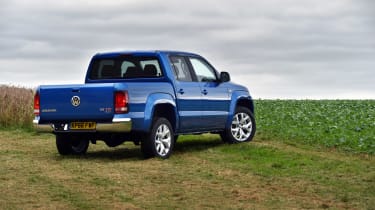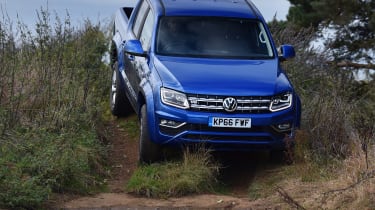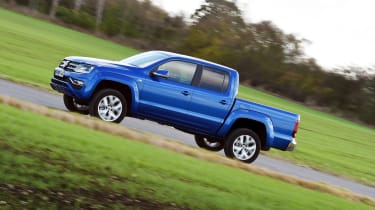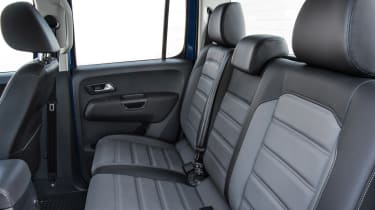Volkswagen Amarok pick-up (2011-2022) review
Meaty 3.0 V6 diesel and a quality finish give the Amarok a classier feel than most truck rivals
The Volkswagen Amarok is a staple of the German firm's line-up, and is a pick-up truck alternative to the company's Tiguan and Touareg SUVs. It's sold by VW Commercial Vehicles, so is available at any of its van centres across the country, but it also doubles as a user-friendly and relatively upmarket family car if you need a vehicle for business and private needs.
The original Amarok arrived in the UK in 2012 and was updated in 2016, when the 2.0 TDI diesel was replaced by a 3.0 V6 TDI. In Europe, standard and extended cab versions of the Amarok were offered, but in the UK the sole body choice was a double cab. This gives the Amarok good space for five, while that big V6 under the bonnet means it's a great car for towing. Add a locking tonneau cover to the load bed, and it turns the Amarok into a large and practical family car.
As of 2020, production of the Amarok had ceased, but VW built enough so that existing stock would remain available until the next-generation Amarok is revealed in 2021.
The Amarok was pricier than most of its pick-up truck rivals, but it's a more upmarket choice. Thanks to the V6 engine offered from 2016 onwards, the only real rival to the Amarok was the Mercedes X-Class. Top-spec versions of the Mitsubishi L200 (or its Fiat Fullback cousin), Nissan Navara, Ford Ranger and Toyota Hilux weren't as powerful, but all offered their own qualities.
Used - available now

2023 Ford
Kuga
47,524 milesAutomaticPetrol2.5L
Cash £19,300
2020 Land Rover
Range Rover Velar
63,000 milesAutomaticDiesel3.0L
Cash £25,995
2020 BMW
X3
48,000 milesAutomaticDiesel2.0L
Cash £23,995
2020 BMW
X3
40,700 milesAutomaticDiesel3.0L
Cash £33,995The VW's V6 came in three power outputs, badged 163PS, 204PS and 258PS. The least powerful engine was geared towards work use and only came in entry-level Trendline trim with six-speed manual gearbox and selectable 4WD. The 204PS engine also had this transmission set-up in Trendline trim, but the eight-speed auto with permanent 4MOTION 4WD was offered as an option. This set-up was also offered in Highline spec, while the 258PS engine only came in Highline auto spec. VW also offered Amarok special editions, such as Aventura, Black Edition, Canyon and Atacama, which added kit and usually came with the most powerful diesel option.
As the Amarok is a commercial vehicle with a payload in excess of one tonne, business users could buy one at the ex-VAT price. Road tax and a flat rate of Benefit in Kind tax make the most expensive versions an attractive alternative to a premium SUV, too.
That load bed has plenty of space between the arches and a wide tailgate opening to load bulky items. There's also a towing weight of up to 3.1 tonnes for the more powerful diesels, and even the 163PS version can tow three tonnes, makin it a good choice for people regularly pulling trailers.
MPG, CO2 and Running Costs
While four V6 TDI diesel engine options were available (163PS manual, 204PS manual, 204PS auto and 258PS auto), none of them were particularly economical. On the WLTP test, VW claims up to 28.2mpg for both of the high-powered diesel autos, while the six-speed manual-equipped cars manage 32.5mpg in older NEDC tests. This doesn't bode well for real-world driving, but we have managed a return of 30mpg in the 204PS auto Amarok when we've tested it, which isn't too shabby considering the engine's power advantage over most of its rivals. Add in an 80-litre fuel tank, and you should manage well over 500 miles between fills. There's also a 13-litre AdBlue tank, and the Amarok's trip computer will give plenty of warning as to when it will need refilling.
A variable servicing system means the on-board computer tells owners when the Amarok needs a check-up. The calculations are made according to how the truck has been driven, but the pick-up can go as much as two years or 25,000 miles between dealer visits. VW touts a four-year servicing package on the Amarok, costing around £675, which is more affordable than Mitsubishi’s £750 offering on the L200 and the Ford Ranger’s £850 deal. Both of these rivals’ packages are also limited to only three years.
Prices are very much within the realms of the ‘premium pick-up’, especially if you go for the higher spec Amaroks with the touchscreen infotainment system, although the Amarok is less expensive than the Mercedes X-Class.
For company car drivers considering swapping out of an estate car or SUV, the tax advantages of driving the Amarok will arguably be even more significant than before. That’s because the Benefit-in-Kind rate for such vehicles is pegged low and doesn’t rise with list prices. Volkswagen would also point to buoyant residual values for its products that will pay dividends come resale time.
Road tax is also a positive point when you're looking at the most powerful version of the Amarok V6. The 258PS model has a list price over £42,000, but while cars that cost more than £40k pay a premium for road tax that pushes it closer to £500 in the first five years, the Amarok currently has a flat-rate of road tax at £265.
Load Space and Practicality
The load bed in the VW Amarok is one of the largest of any double-cab pick-up available in the UK. It has a volume of 2.5 square metres – and although buyers elsewhere in Europe used to be offered a bigger capacity where the Amarok was sold with a single cab, that option has now disappeared altogether.
Still, the double-cab UK model has one of the widest bodies around, and these dimensions pay off with a maximum width of 1.22 metres between the rear wheelarches. That's big enough to take a Europallet sideways in the back. All versions of the facelifted Amarok have a payload weight in excess of one tonne, so customers can reclaim VAT if they’re registered business users. Thanks to the 3.0-litre TDI V6 diesel in its various states of tune, all versions of the Amarok will be able to tow a 3,000kg trailer, with the highest spec versions capable of pulling 3,100kg.
The load area comes with four lashing rings, although a rear window rack is a £170 option. Other extras include a protective coating for the painted load bed for £810, an electric tow bar for £300 (the Amarok is pre-prepared to accept it, so there are no extras you need to buy on top of this), while VW can supply a variety of soft or hardtop tonneau covers to secure the load bed. However, while these tonneaus are fitted with rubber seals, they don't make the load bed completely water tight, so don't expect the security of a car's boot here.
Underbody protection can also be specified by owners planning to use their Amarok off-road. However, all versions come with ESP (electronic stability programme) as standard, and the package includes a trailer stabilisation system that uses the vehicle’s anti-skid and ABS brake systems to maintain control if your trailer starts to wander.
Reliability and Safety
The Amarok is one of the safest choices on the pickup market. Not only does the VW get standard ESP, there's also an off-road function that allows a bit of slip when you want it in muddy conditions. Plus, there’s an electronic differential lock, while hill start assist and hill descent assist ensure you can pull away cleanly on steep inclines and then descend slippery off-road drops safely.
If you're going to use the Amarok off-road on a regular basis, there's a centre diff lock available for about £300 and extra under-body protection is offered.
VW’s Post Collision System has been added to the mix too, which is designed to help limit the damage caused by secondary impacts during an accident. Indeed, the raft of electronic driver aids will ensure the Amarok always behaves as you’d expect, whether you’re on or off the tarmac.
All versions of the Amarok come with driver, front passenger and front side/head airbags, while other standard kit includes air-conditioning and heated door mirrors. The big VW has so far proved to be a decent performer, and owners haven’t reported any major reliability problems – and many of the components have already proven durable in other products from the company - including the V6 engine.
As the Amarok is sold via Volkwswagen Van Centres, our Driver Power data on VW's dealer network performance can't be directly attributed to them.
Insurance
The Amarok falls into insurance groups 40-43, which is quite high - even the most powerful Mercedes X-Class is only in Group 40.
Driving and Performance
The Amarok's diesel motor is refined on start up and when driving. Although it can be a little loud under hard acceleration, the rough, rumbling engine note that’s common in four-cylinder trucks is replaced with a smooth, muted roar. The engine itself is refined at cruising speeds, but there’s a fair amount of wind noise generated by the squared-off panels and huge wing mirrors, so it’s not the most refined motorway cruiser.
Given its large dimensions and considerable weight, the truck rides quite well, and there’s not much of the bounce from the rear end that you get in some unladen pick-ups. There’s a pleasant suppleness to the low speed ride but at higher speeds minor undulations do set the Amarok into a bouncing motion at times. The steering isn’t the best you’ll find in a one-tonne truck either, lacking the response to smaller inputs that you want on faster B-roads. At least there’s plenty of grip and the Amarok seems to hold on well in corners, putting its power down cleanly with the aid of that permanent 4x4 system.
If ride comfort is a priority, the permanent 4Motion model features slightly softer suspension. Previously this came at the expense of carrying capacity – and as the model’s payload didn’t exceed a tonne, owners weren’t able to reclaim VAT on their purchase. However that situation has been resolved in the latest model.
Fitting the biggest 19-inch wheels does make the suspension fidget a little more than when smaller wheels are fitted, but it's not a deal-breaker.
Engines
The Amarok’s 3.0-litre diesel is refined and smooth. The top-spec version delivers performance that's borderline hilarious, as this massive truck hurls itself at the horizon like a hot hatch. It has 580Nm of torque, which feels like enough to pull tree stumps out of the ground, and more than enough acceleration for most situations on the road. 0-62mph comes up in just 7.4 seconds, while top speed is 127mph. The VW feels significantly faster in a straight line than other UK pick-ups, except for the Mercedes X 350 d.
Cab and Interior
Many manufacturers claim that their commercial vehicles feel ‘car-like’ from behind the wheel, but the Volkswagen Amarok delivers, although not quite to the same level as the Mercedes X-Class. While there’s no getting away from its massive dimensions – the pick-up feels particularly wide on country lanes – the cab is very comfortable. The rear seats provide plenty of legroom for passengers with loads of head room and seat bases that are higher off the floor than in rival trucks, so you don't have to bunch your knees up in the back.
Equipment is generous, with even the base Trendline featuring heated electric mirrors, electric windows, semi-automatic air-conditioning and a CD/radio, cruise control, a multifunction trip computer, a six-speaker stereo and two-zone automatic air-conditioning. The steering wheel and gearlever are trimmed in leather, plus there are carpet floor coverings and storage drawers under the front seats, while on the outside are 17-inch alloys. Range-topping Highline models add 18-inch alloys, leather upholstery, heated front seats, front and rear parking sensors, and privacy glass.
The fascia design is attractive and well put together – especially so for a commercial vehicle – and helps to give the cabin an upmarket ambience, although again the X-Class takes this to another level. The 6.3-inch touchscreen Discover Media option costs £672 on Trendline cars and is standard with Highline trim. The sat-nav is easy enough to use, with clear graphics and intuitive controls.
The small screen is a bit of a barrier to usability in some ways, because the virtual buttons displayed on the screen are quite small and fiddly, but the good news is that with VW’s App-connect system you can run your smartphone’s mapping programme through the infotainment system. That’s probably a better option if you have a compatible phone – but the fact that built-in navigation is standard on the other trucks is a mark against the Amarok. Voice control functionality and DAB are the other main benefits of choosing the optional system.
Van dimensions
| Body style | Height | Width | Length |
| Double-cab pick-up | 1,834mm | 1,954mm | 5,254mm |
(Width measurements are without wing mirrors – 2,228mm incl. mirrors)
Load area dimensions
| Body style | Height | Width | Length | Volume |
| Double-cab pick-up | 508mm | 1,620mm | 1,555mm | 1.28m3 |
(Widths are maximum. Width between wheelarches is 1,222mm)















